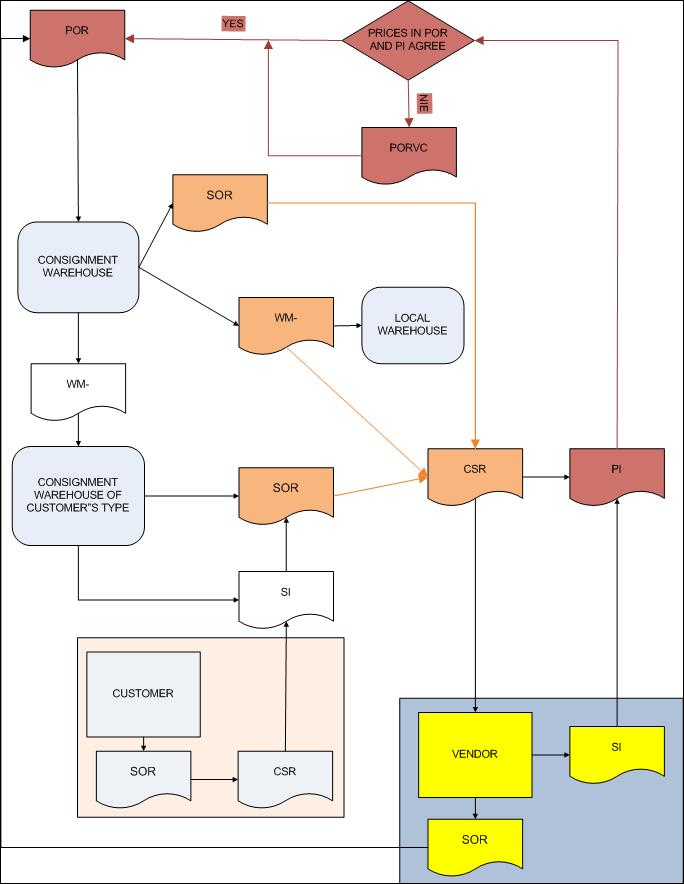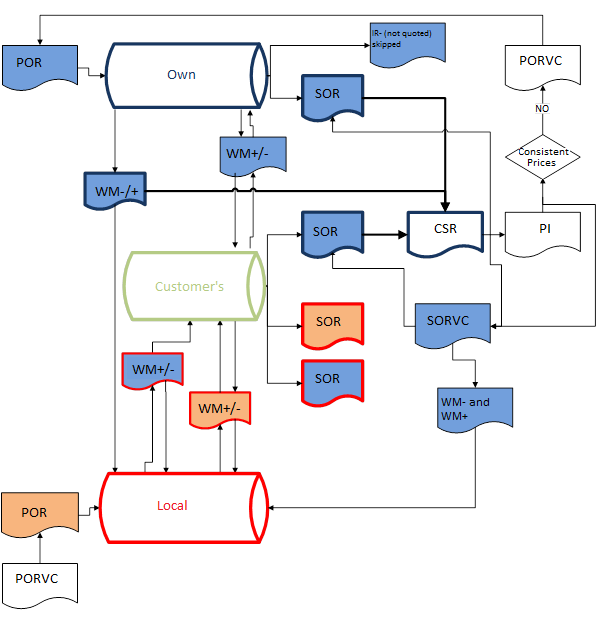This article presents a simplified example of documents circulation between vendor, customer and secondary customer.

Consignment stages presented in the diagram:
- A vendor releases an item from its warehouse to the so-called consignment warehouse and issues a warehouse document for a customer, e.g. a SOR
- A customer receives the item from the vendor to the consignment warehouse on the basis of the warehouse document issued by the vendor and next the customer issues a POR document to the vendor to its own consignment warehouse
- The customer:
- sells the item received in the consignment warehouse of Own type and documents it through sales invoices or receipts associated with the SOR documents for the item sold
- acquires the item for its own needs moving it to its own local warehouse by using WM-/WM+ documents (the source warehouse will be its own consignment warehouse, the target warehouse – a local warehouse)
- moves the item to a consignment warehouse of its secondary customer by means of WM-/WM+ documents (the source warehouse will be its own consignment warehouse, the target warehouse – a consignment warehouse of the secondary customer)
- In the event when the customer has moved the merchandise to a consignment warehouse of its secondary customer:
- the customer sells the item from the warehouse in which they have received it
- after the sale the secondary customer provides the customer with a consignment sales report
- on the basis of this report the customer creates SI and SOR documents to its secondary customer from the consignment warehouse of the secondary customer, thereby making the sale and settlement with their customer
- The customer informs the vendor which items from the consignment warehouse of Own type have been sold, including those which have been sold by its secondary customer from the consignment warehouse of the secondary customer
- On this basis, the vendor issues a sales invoice document to the customer, in which there are listed the items sold by the customer (and their secondary customers). At this moment, the actual sale of the merchandise by the vendor for the customer takes place
- On the basis of the sales invoice received from the vendor, the customer records the purchase invoice document to the vendor, associating the items of the invoice with the items of the POR documents with which the merchandise was received in the consignment warehouse of Own type
- If the prices in the purchase invoice and the POR document are different, the customer issues a value correction document to the POR document.
In case a company is also vendor of consignment goods, the consignment path might be extended:
- the reproduction of the transfer of goods within consignment is registered with the help of WM- document from a local warehouse to a customer’s consignment warehouse
- after receiving a sales report from a “customer”, payment is processed according to the standard path, described in the above process, that is by means of SI/R and SOR issued for the customer assigned to the consignment warehouse of Customer’s type and which contains the resources from that warehouse.
A diagram presenting almost full path (without ordering stage) of subsequent operations performed on a delivery received in a consignment warehouse of Customer’s type, as well as operations on a resource moved from a local warehouse to a consignment warehouse looks as follows:

Fill color in the above diagram determines type of delivery:
- blue – a resource from a delivery received in own consignment warehouse
- orange – a resource from a delivery received in a local warehouse
Shape outline color in the above diagram determines:
- red – that a resource went through a local warehouse regardless of where it was received
- blue – documents which can be added to a CSR from a delivery received in own consignment warehouse
The process always starts from a POR document which registers a delivery in own consignment warehouse or local warehouse. Although the diagram presented above does not illustrate it, an item can also be received in a local warehouse by an IR+ document.
Attention should be paid to the following operations when analyzing the consignment process, and so, the update of resources in this process:
- a CSR includes SOR documents issued to:
- own consignment warehouse
- consignment warehouse of Customer’s type, but only if a resource released by these documents was originally received to own consignment warehouse and have not been moved to any local warehouse in in the meantime
- a CSR includes WM- and WM+ documents which move an item from own consignment warehouse to a local warehouse
- items not included in a CSR are subject to quotation
- it is necessary to distinguish WM- and WM+ documents issued manually and moving an item from own/customer’s consignment warehouse to a local warehouse from which have been generated automatically to a SORQC
- WM- and WM+ documents issued manually are subject to quotation only if they have been added to a CSR, they are subject to quotation until they are not added a CSR
- WM- and WM+ documents issued automatically to a CSR are subject to quotation only if a CC has been generated to a SORQC associated with those documents, on the basis of the CC generated to the SORQC, there are cost corrections generated to WM- and WM+ documents as well as to subsequent documents in the presented path; or resources included in this WM+ are updated in the warehouse
- WM- and WM+ documents which move an item from own consignment warehouse to consignment warehouse of Customer’s type are quoted only after SOR documents releasing the moved resources are quoted; such WM- and WM+ documents will not be quoted until a resource they move is not added to a CSR with the use of a SOR issued in consignment warehouse of Customer’s type
- other documents, that is: IR-s, although they include resources created by a delivery received in own consignment warehouse, will never be quoted (when quoting from a CSR); while updating and generating a CC, such documents are not taken into account at all
- SOR documents issued in consignment warehouse of Customer’s type and using resources going through a local warehouse will not be included in a CSR, and thus, they are not subject to quoting
